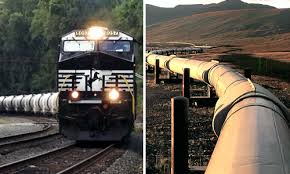Pipeline Safer Than Train

Since the accident in Lac-Mégantic, a lot of people are worried about how oil is moved around North America. After many incidents, involving trains and in pipelines, environmentalists in Canada and United States started to look for a safe way to move oil across the two countries, but no one seems to agree on the safest way to do so.
Transporting oil by rail is more dangerous than moving it by pipeline. The Fraser Institute told than the rates of incidents or accidents per millions barrels of transported crude is 4.5 times higher for rail than for pipeline between 2003 and 2013. “In both Canada and the United States, rising oil and natural gas production necessitates the expansion of our transportation capacity,” said Kenneth Green.“Most rail accidents come down to human operator error,” he said.
The problem :
The amount of oil and gas being transported has rapidly increased during the past five years.The study acknowledges there were more incidents with pipelines than rail during this decade — 1,226 pipeline incidents compared with 127 for rail — but states pipelines move 15 times more petroleum than railways, and are safer when volume and distance are taken into consideration. The CBC News reveals details about more than 1000 incidents that have happened across the country from 2000 until late 2012 and suggest the rate of overall incidents has doubled.
The incidents in Canada :
2014, January 25, a TransCanada Corporation gas transmission pipeline exploded and burned, causing a natural gas shortage in Manitoba and parts of the United States.
2015, July 15, a pipeline at a Long Lake oil sands facility in northern Alberta leaked about 31,500 barrels of oil emulsion. The spill covered approximately 16,000 square meters but was mostly contained.
2015, August 14, a leak from a pipeline spilled about 100,000 liters of oil, water, and gas emulsion at Hay Lake First Nation in Alberta.
The alternative :
Some see rail as a viable alternative to the leaks, high construction costs and the vast opposition to pipeline projects. But there are enormous risks. The danger of transporting crude oil by rail was highlighted two years ago with the Lac-Mégantic disaster in Quebec, when a freight train carrying crude oil derailed and exploded, destroying part of the town and killing 47 people. There has been several other fiery crashes since this time.
Finally, many people think there isn’t a safe way to move oil after all the incidents that happened everywhere in Canada and in the United States.
Sources : business.financialpost.com, www.manhattan-institute.org, www.economics21.org, www.cbc.ca





